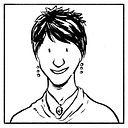Creating Contact Zones
Civic aspiration is a powerful thing — it gives moral imagination someplace to go. — Krista Tippett, Journalist
When you begin to imagine and act as if you live in the world you want to live in, you will have company. — Bernice Johnson Regan, Singer/Civil Rights Activist
These quotes that have been rolling around in my head a lot lately.
I’m the Senior Community Engagement Strategist at an National Public Radio affiliate, pioneering new ways to bring together journalists, community members and powerbrokers to explore issues and propose solutions for the places we live.
If there is any institution uniquely positioned to activate the public imagination these days, it’s public radio. We’re an independent public service network made up of artful storytellers and huge, devoted audiences. Because our audience represents a narrow demographic, the potential to reflect the distinct and diverse voices within our communities is seismic.
Which leads to me the question: How can public radio create a new kind of listening experience where wildly diverse people come together and imagine as communities, examining the world as it is and the world as it could be, and how to get from here to there?
Here’s one idea: by creating Contact Zones.
It’s a term coined by Stanford literature professor Mary Louise Pratt. She uses it to refer to “social spaces where cultures meet, clash, and grapple with each other, often in contexts of highly asymmetrical relations of power.” Educators, artists and scholars have drawn on Pratt’s concept to explore what happens when you bring together people of varying relationships with power to share experiences, negotiate differences, make discoveries and apply them in their lives.
I’ve adapted Contact Zones to my work in a slightly differently way, designing encounters where people who wouldn’t ordinarily cross paths come together and wrestle with social issues and each other’s messy experiences of them. Where powerful radio pieces ignite personal story sharing and frank conversation — the kind that busts stereotypes and generates emotional border crossings — in an atmosphere that is beautiful, respectful and relevant. Food, music and movement are also part of the mix.
I’ve started creating Contact Zones through participatory public radio events that are part civic meeting, part art happening and part dinner party.
Here’s what I’ve learned so far:
We dream better when we combine purpose with pleasure. When we infuse our public dialogue processes with delight, hospitality and regard. When curiosity, empathy and a sense of belonging act as the critical yeast for metabolizing tough issues.This requires paying careful attention to location, curation and facilitation. Because of the segregated communities in which we live, we can’t expect people from different walks of life to naturally gather or get along. It takes active outreach, a sincere and welcoming invitation and structured conversation. Community collaboration in event design and leadership is crucial.
Building trust between institutions and communities begins with creating spaces and processes for people to speak and feel heard. This is especially true between the media and disenfranchised and under-represented communities. Trust evolves as long as communal input and stewardship is welcome and flourishes and when the effort is mutually rewarding for everyone involved.
Community visioning, bridge building and civic storytelling — this is what I’m experimenting with through my work at Capital Public Radio.
Over the next few months, I’ll share dispatches that document lessons learned from my most recent community engaged documentary project, The View From Here: Place and Privilege. My hope is that these reflections inspire and support others working to mobilize our public imagination toward building community capacity for empathy, equity and democratic change.
Stay tuned.
jesikah maria ross produces participatory media projects that generate public dialogue and community change. She brings journalists and community stakeholders together, creating a path and a plan that changes how we collect, tell and share the stories of our communities. She is the Senior Community Engagement Strategist at Capital Public Radio, Sacramento’s NPR affiliate and Public Imagination Fellow at the Yerba Buena Center for the Arts in San Francisco. @jmr_MediaSpark, jesikahmariaross.com
